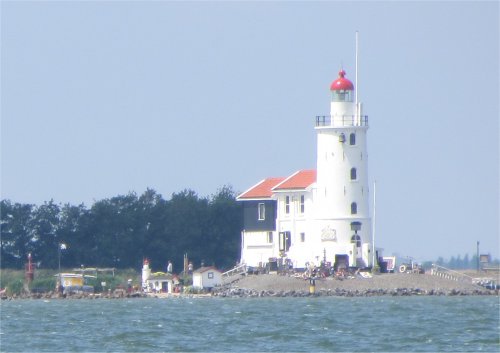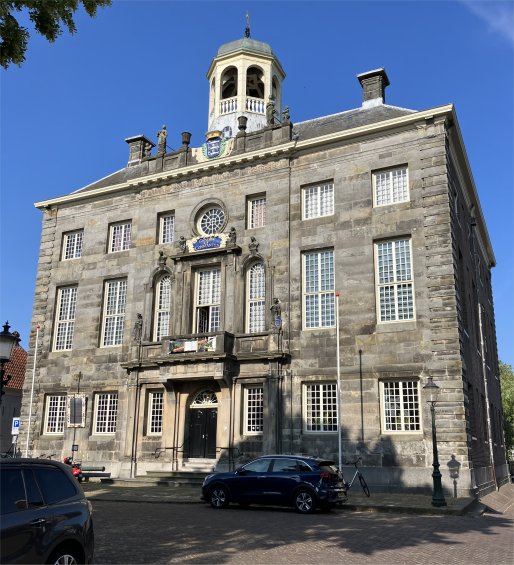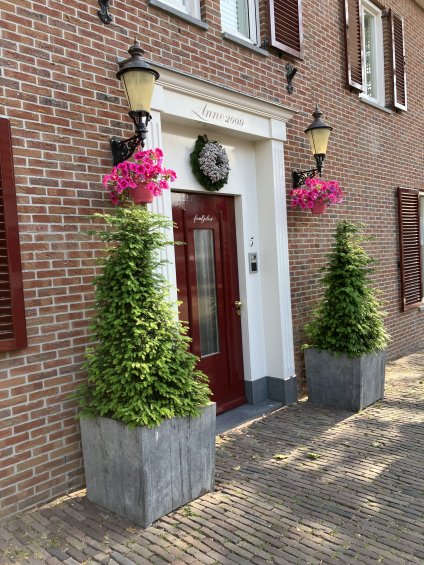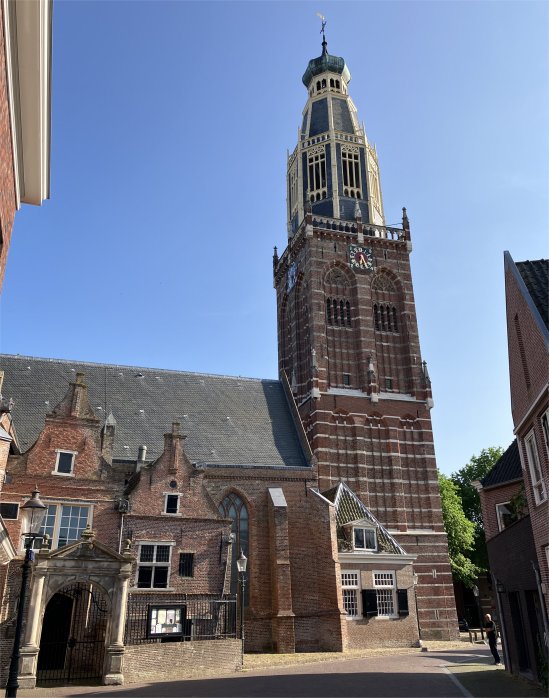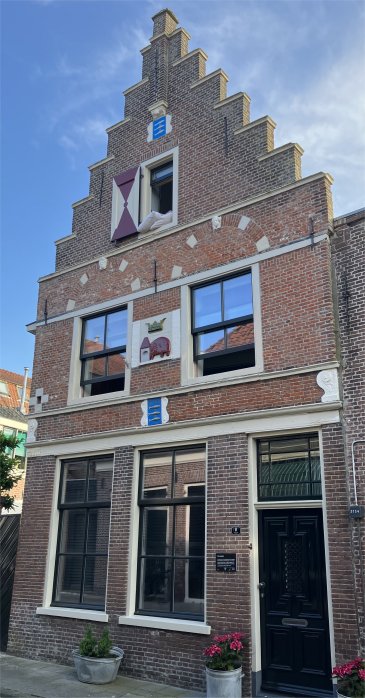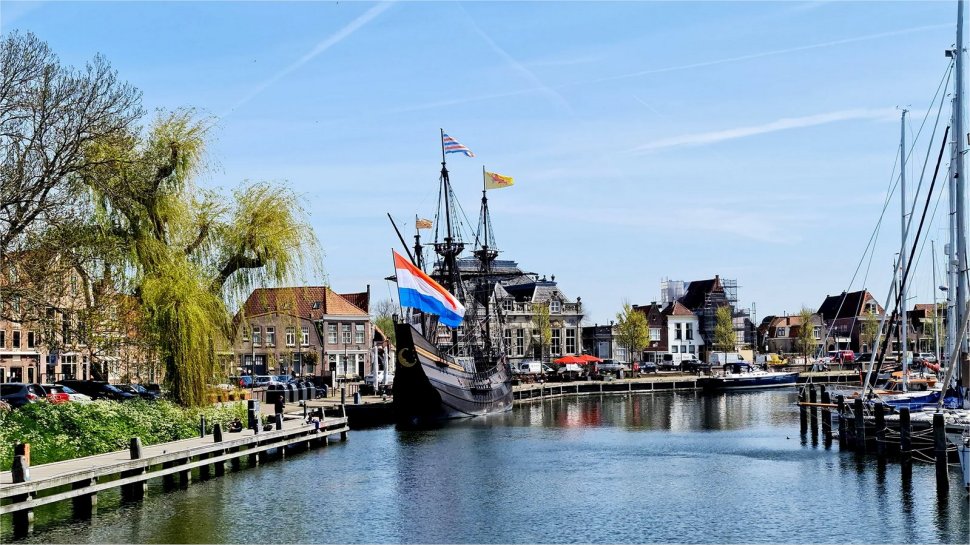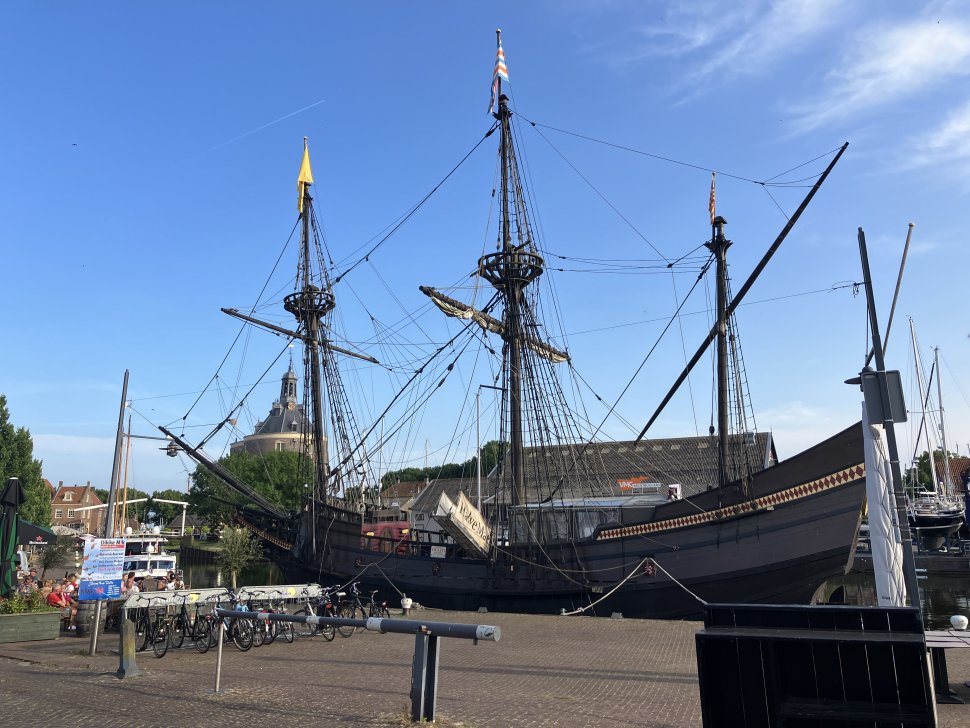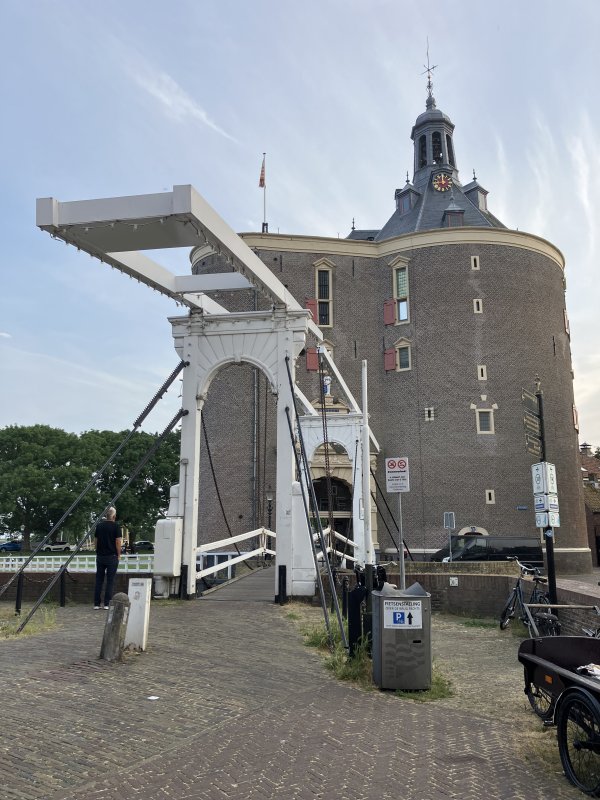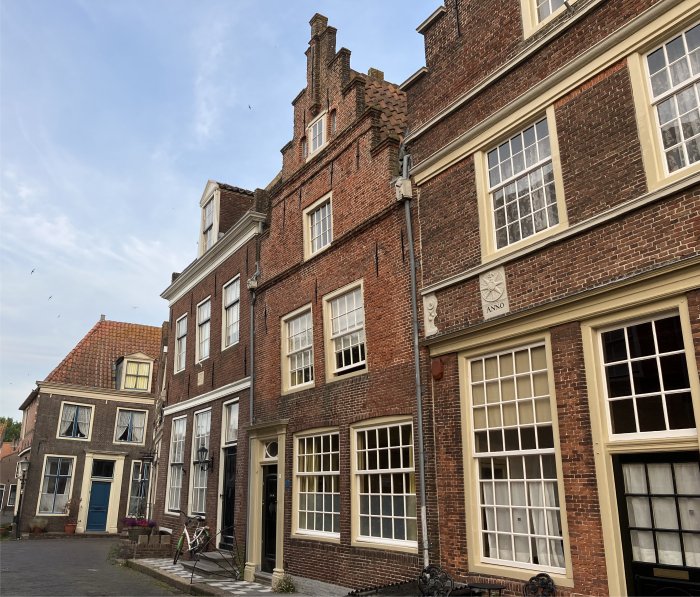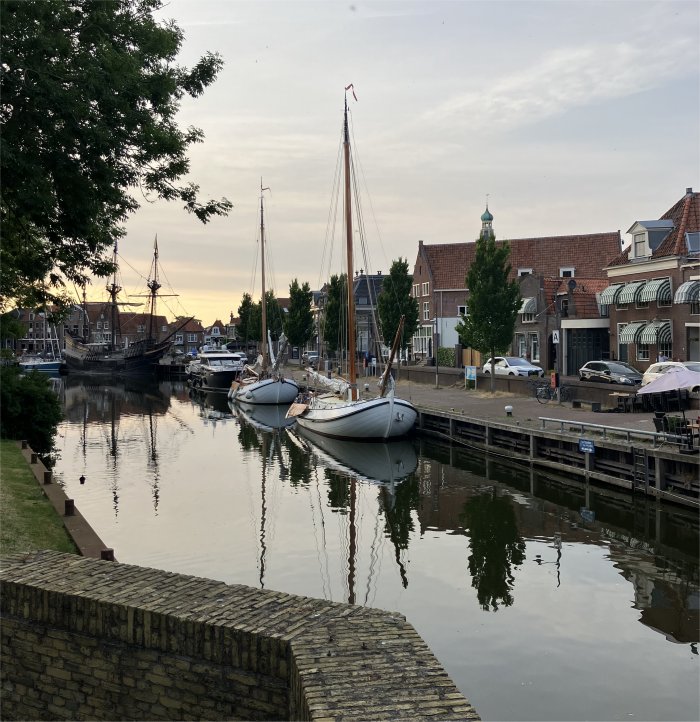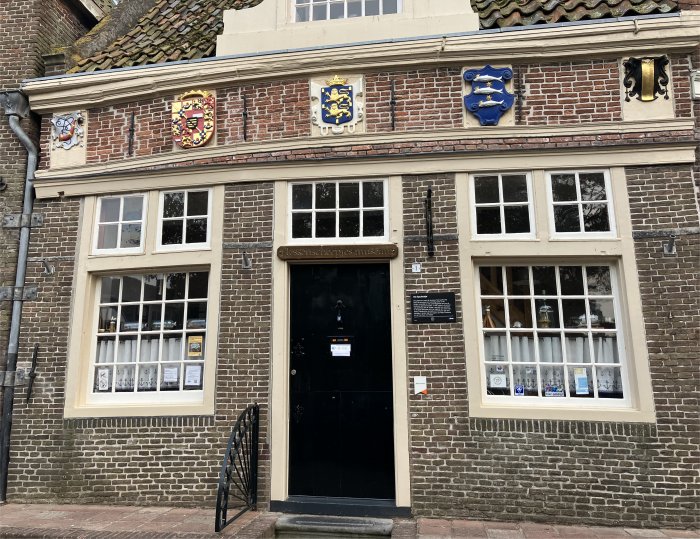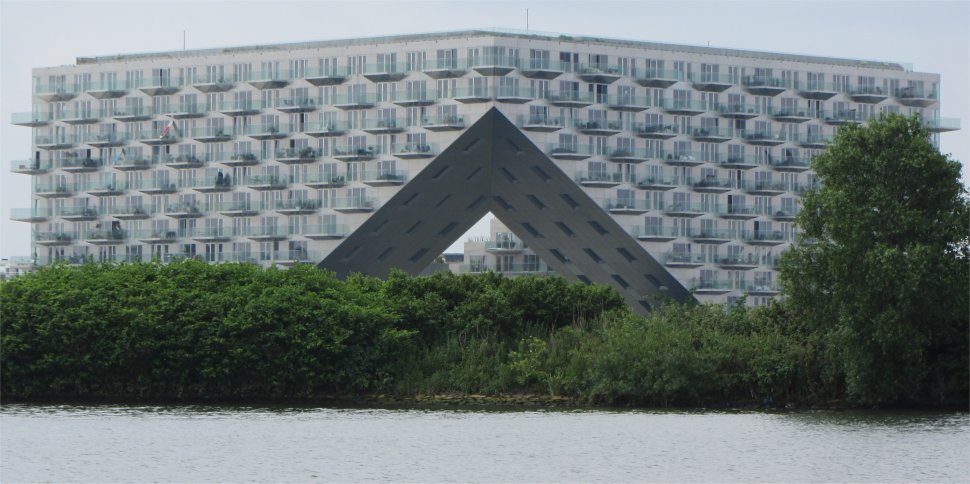 Intriguing Architecture |
At 07:15, an almighty din started up which must have woken half the marina. I heard Rex fly out of his pit to determine the source of the sound. About 30m from our berth, a crane on a floating barge was driving in new pilings. A strong wind was howling and the temperature had dropped noticeably.
After showers, taking on fresh water, and buying in more provisions, we slipped our lines and made our way down the North Sea Canal, passing the Centraal Station with its incessant ferry traffic, and headed towards the Oranjensluizen. A couple of policemen in a RIB sped by giving us a cheery wave, then five minutes later they came alongside, and flagged us down. They were performing border patrol duties and asked to see our passports.
"Where have you come from?"
"Across the North Sea from the UK," replied Rex.
"To Ijmuiden?"
"No," I replied, "we entered the EU at Oostende in Belgium."
Rex added the route we had taken up to Amsterdam.
"Have you had any problems?"
"The Haringvlietbrug." I replied, at which they laughed.
"If you have any questions, feel free to ask," piped up one of the chaps, who passed me his card for the Marechaussee. "The dumbest question is the one that never gets asked." Meanwhile, his colleague had checked out details of our entry into Ostend, had taken photographs of the passport stamps, and was happy. The two then beamed with smiles, wished us a good and safe trip, and left to find another non-EU yacht.
| Durgerdam (please use scroll bar) |
|
We painlessly negotiated the sluis and the following bridge, and down the narrow channel past Durgerdam and the tiny island of Vuurtoreneiland just south of Hoek van't Ij. It is a beautiful private island at the south western end of the Markermeer. The original lighthouse on the island was built three centuries ago and is the only lighthouse in Amsterdam. The island is set up as a nature preserve and there are plans to restore the fort there so that visitors can experience it. It is possible to take a boat from the city to the island to enjoy a meal at the restaurant there. Then we were out into the Markermeer. Before us lay four hours of cruising up the Markermeer towards our route through the Markerwaarddijk into the Ijsselmeer at Enkhuizen.
Approaching the lock, we noticed a few yachts on the waiting pontoon already. As we approached to moor up as well, the lights to the lock turned green, so I urged Rex to just put on a spurt and enter the lock. The other boats duly followed. One had particular difficulty berthing on the windward side of the lock, and her stern was being pushed away by the wind towards the yachts moored on the opposite side. There were a few clanks from their anchor hitting the lock side, plus shouts and screams from the other yachts about to be smitten. Shit happens. Then, in next to no time, the exit gates opened, and we shot out of the lock. The first time we have ever won the race out of a lock; Rex was ecstatic. We arrived into the Compagnieshaven in Enkhuizen and berthed with a few other yachts on the Meldsteiger. As usual I wandered up to see the harbour master, who I spotted jumping on his bike and heading off home. All of us new arrivals wondered whether we should stay on the Meldsteiger or try to find an empty box. The danger with the latter option is that the owner may return and turf us out. A Dutch fellow I was talking to tried to ring the harbour master, but got no response. I enquired at the onsite shop. I recognised the shop owner from last year; a friendly, chatty fellow. He advised that people just tie up at the Meldsteiger in these circumstances. So, I passed this message on to the rest of the late arrivals, and we were all happy bunnies.
Rex and I headed into the pretty town of Enkhuizen, a town we had and his wife Meryl had visited many times. Enkhuizen was the administrative centre of Friesland until 1289, when western Friesland became part of the County of Holland. Count Floris V granted the town its municipal charter in 1355, and thereafter it began to flourish. It was one of the harbour-towns of the VOC, just like Hoorn and Amsterdam, from where overseas trade with the East Indies was conducted. The town walls were built around 1550 and strengthened in the early 17th century. Enkhuizen was one of the first towns to revolt against Spanish rule in 1572. Its ships, along with those of Hoorn, Edam and Monnickendam, took part in the naval battle in October 1573 in which a Spanish fleet commanded by Admiral Bossu was defeated. The population fell sharply after an outbreak of plague in 1636. In the mid-17th century, Enkhuizen was at the peak of its power and was one of the most important harbour cities in the Netherlands. However, due to a variety of reasons, notably the silting up of the harbours, Enkhuizen lost its position to Amsterdam. The history of the East India Company, known as VOC, in Enkhuizen is still clearly visible. The VOC was in the 17th and 18th centuries the largest trading company in the world, and its magnificent ships travelled to Asian countries to trade. The convenient location on the Ijsselmeer made it attractive to settle here. A "Chamber of the VOC", the Drommedaris, the defence tower on the harbour, and the centre of the historic buildings, reminded us of this prosperous time.
There was a riotous crowd in the outside seating area; noisy, full of banter and raucous laughing - typically Dutch and an ideal place to people watch. A large open back truck laden with marquee and barrier equipment came by, stopped, and reversed at an angle to hitch up a trailer also similarly laden. The driver was a little harsh and nearly smashed up his towbar. Three men then hitched up the trailer. However, the truck was in no hurry to move off. Meanwhile a car came up behind the truck and trailer, wanting to overtake the combination. But since the truck driver had parked at an angle leaving his front end well across the road, there was not much room to overtake it. Dialogue then took place between the woman driving the car and the crowd at the bar, with much humorous shouting and cheering. The woman started tooting her horn to no effect. In despair, she got out of her car, walked over to the restaurant next door where she proceeded to move outside chairs and tables, returned to her car and drove through the gap she had newly created. A tremendous cheer went up from the bar. More traffic, cyclists and pedestrians had to follow through the gap that had been created. Eventually the truck driver set off with his trailer along the road. Five minutes later a smaller flat back went by with barriers on board, plus two youths standing on the back. Again, numerous banter and laughter were exchanged between the bar crowd and youths. Moments later a bike followed it, with a lad sitting on the parcel tray at the back behind the pedalling lad. Again, there was much humorous interchange between the two lads and the bar folk. To my right sat a couple and their twentysomething daughter. "Can you recommend a good restaurant", I asked. "Do you want to eat fish or meat?", they replied. "Probably meat". "Then you must go to Dikke Mik; it is down by the Oude Haven". The daughter pointed out its location on my phone. There then followed some banter between this family and a group sitting further along the bar, again as always with much mirth and shouting. The daughter informed us, "Dikke Mik is open, I have just asked the owner who also owns this bar. He is the man wearing the black shirt." I thanked the young woman; most of the men in that group wore black shirts. We finished our beers, thanked the family, and headed down to Dikke Mik. Soon we were ensconced on an outside terrace by the Oude Haven, surrounded by several other tables. Once again, we were immersed into a constant hum of loud talking and humour. Moored in the Oude Haven, only 3m away from us, lay the Halve Maen (Half Moon). We had seen this replica ship several times before at Hoorn, and was now doing a tour around the country. This 21m long ship was a replica of a Dutch East India Company vlieboot (Dutch version of a carrack) which sailed into what is now New York Harbour in September 1609. She was commissioned by the VOC Chamber of Amsterdam in the Dutch Republic to covertly find a western passage to China. The ship was captained by Henry Hudson, an Englishman in the service of the Dutch Republic. In 1909, the Netherlands presented the United States with a replica of Halve Maen in order to commemorate the 300th anniversary of Hudson's voyage; the replica was destroyed in a 1934 fire. Eighty years later, the New Netherland Museum commissioned a second replica.
An enjoyable meal followed. High above us in the warm air swifts soared catching wind-borne insects. What a delightful way to end the day. A short walk down the Oude Haven brought us to the Drommedaris. The tower is a relic of the town's fortifications (1540). The tower, which was heightened in 1649, has a carillon by the Hemony brothers which ranks among the finest in the Netherlands. It served at one time as a prison, and some of the cells can still be seen. As we walked back to Duonita, boats were still entering the marina and tying up where they could. Back on board, we sat in the cockpit, from where I spotted a pair of grebe chicks paddling aimlessly, then one of the parents surfaced with a small fish which was greedily snatched by one of the chicks. The parent dived to repeat the routine again. Coots scuttled about between boats calling out their characteristic sounds. We discussed plans for the following day, and decided to head to Hindeloopen instead of Lemer, the latter not really holding enough interest to attract us there.
|
|




